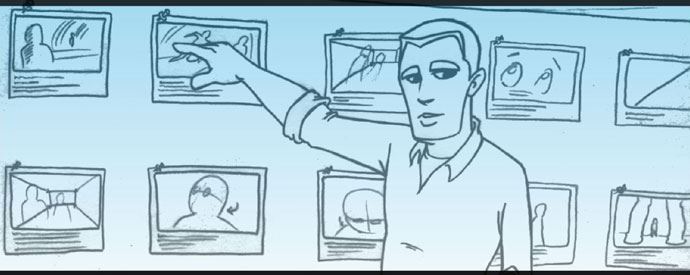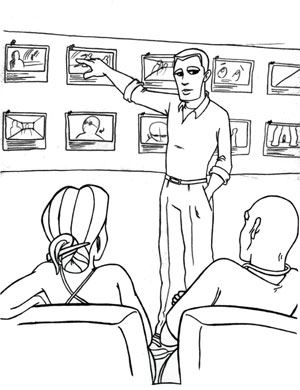Comics /
Spotlight
Comic Problems #3 Learn Comics in Art School?

By Hervé St-Louis
March 1, 2016 - 12:20
Question: Should I go to art school to learn comics or not?
Answer: This is a classic question that has plagued many upcoming creators and is not easy. But my position on this issue is that if possible, learn the trade in school and more in an apprenticeship.
First, when discussing the relevance of an art education, one must subtract the affordability issues. Affordability is a problem for many potential American students. This is an issue that Democratic candidate Bernie Sanders is tackling head on. In the United States, it costs a lot of money to go to college. The education that used to be used as leverage to improve the lives of people can now cripple graduates with debts. Affordability affects people’s decisions. Often criticisms of art education start and end with affordability as opposed to the actual merit of education.
When affordability is not the main argument against art school education, job prospects are. You’ll read anecdotal and more serious accounts about how art school graduates only find jobs as baristas or pizza deliverers. Again, the merit of an art education is reduced to numbers and money. No degrees can ever promise that all of its graduates will find full employment. Life is complex. Situations and opportunities changes and artists who land great jobs or gigs that they want are those who are able to seize the day in the industries. Any school who promises you full employment without any effort from you as the learner is suspect.
Another argument I see nowadays is the availability of online resources and access to libraries to learn on your own. Here is a question for those of you that you who argue that books and YouTube tutorials can replace schools. The classic artists of Western culture and even those from Africa, China and Japan learned through apprenticeships. They worked under a master for years before being able to master their craft. The tutelage and studio interaction was fundamental to their learning. What is it then about humans that has changed that would make how we learn things different than all of the illustrious artists of the past?
Well, nothing about our biology or mind has changed. What has changed is our environments and how we interact with technology and increased access to knowledge. But we as humans are virtually the same, if not a bit healthier. Being able to access and learn from books, technology and other sources of information assumes a rudimentary form of literacy. You can only acquire this rudimentary form of literacy through learning. In order to get the most from YouTube tutorials and advanced books about art, it may be that one needs to have some form of rudimentary knowledge about how to learn and think critically.
What proper and formalized art education provides are the fundamental skills to get the most out of learning on your own. Formal education offers the building construction blocks and the space to experiment and make mistakes, learn from your peers and have direct criticisms from your instructors. Having homework and assignments is a sure way to motivate students to reach beyond their comfort zone. Proper education means that you work with different instructors, students and have to learn critical skills about the domain you are attempting to master. It’s also a way to rigorously test that you have acquired sufficient knowledge and skills as a cartoonist.
Learning with peers and under the tutelage of an instructor can occur in and outside of the college classroom. If you and your friends organize a weekly meet up on making comics in your town, you will achieve human learning the same way the old masters did. What is important in art education is the reflection, the criticism, and interaction with your peers and mentors. It can be formal education or not. But it is definitely not the self-taught paragon that is advanced by many critics of education. I bet your weekly meet up with others will be cheaper too.
I admit to being biased towards formal art education because of part of my duties as a PhD candidate. I teach storyboards at the university. My storyboards classes are popular and appreciated. I have been teaching storyboards since 2004. Reading one textbook or watching a series of YouTube videos will never replace one hour of a storyboard lecture with me. I just don’t transfer knowledge. I force you to discover storyboards through my own infectious enthusiasm for the topic. It’s like watching an actor perform and convince you that storyboards are the most important things in the world.
But what about comics specifically?
Comics as a trade have been recognized in formal education rather late. Now, there are many schools that teach the practical and the theoretical side of sequential art. There are excellent schools in Canada and the United States where one can learn about comics. But comics, like classic painting, were often learned in studios or what today they would call a bullpen. Artists would come in and work in a large place. They would learn from the masters and take on bigger tasks. These early studios, like the one started by Will Eisner provided training for many cartoonists.
In the 1970s, the studio and bullpen almost died and creators had to work alone and send in their work. You’ll notice that in the late 1970s and 1980s, comic styles exploded due in part to the lack of a house style enforced with a bullpen. Tutelage almost ceased to exist. But formal schooling such as at the Joe Kubert School replaced some of the informal training for cartoonists.
There are many resources to learn about making comics today. But again, much of the learning is done through peer reviews and discussions with professionals. Even at comic conventions the portfolio evaluation is a big deal. Frankly, it seems to be very difficult to learn about making comics without any review from another person.
Formal education speeds up the process and teaches the basic techniques all cartoonists need to know. You will practice at least one semester of life drawing, perspective, layout, and storytelling. Projects build on top of previous learning. You could attempt the same on your own, but the experience would not be the same. Now, for a distinct minority, no formal education is needed. I call them savants. They pick up a pencil and a brush one day and just create. Most of us are not savants. Savants are rare. Most cartoonists need formal education with peers and instructors to achieve their full potential.
Last Updated: March 3, 2025 - 20:40

